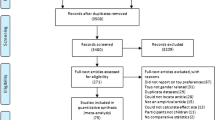Abstract
Preschoolers’ reasons for ranking the beauty of 30 children’s book illustrations were investigated through individual interviews. Most frequent response criteria for beauty were associated with familiar objects or surroundings, action, color, clothing or accessories, water or ice, body features, and babies or small things. Children’s book illustrators should avoid confusing and unfamiliar images when appealing to the preschool child’s interest.
Similar content being viewed by others
REFERENCES
R. C. Bogdan S. K. Biklen (1998) Qualitative research for education: An introduction to theory and methods EditionNumber3 Allyn and Bacon Needham Heights, MA
S., & Bredekamp C. Copple (Eds) (1997) Developmentally appropriate practice in early Childhood programs EditionNumber2 NAEYC Washington, DC
J. C. Brewster (1997) ArticleTitleTeaching young children to make picture books. Early Childhood Education Journal 25 IssueID2 113–117
Edwards, C. P., & Springate, K. W. (1995). Encouraging creativity in early childhood classrooms. Retrieved February 7, 2003, from ERIC-EECE Publications-Digests website: ERIC Document Reproduction Service No. ED389474
M. R. Jalongo (2004) Young children and picture books EditionNumber2 DC: NAEYC Washington
P. Kuby L. Kirkland J. Aldridge (1996) ArticleTitleLearning about environmental print through picture books. Early Childhood Education Journal 24 IssueID1 33–36
InstitutionalAuthorNameNational Art Education Association (NAEA) (1995) National visual arts standards NAEA Reston, VA
Oring, S. A. (April, 2000). A call for visual literacy. School Arts, 99(8), 58
C. Piotrkowski M. Botsko E. Matthews (2000) ArticleTitleParents’ and teachers’ beliefs about children’s school readiness in a high-need community. Early Childhood Research Quarterly 15 IssueID4 537–558
C. T. Ramey S. L. Ramey (1999) Right from birth: Building your child’s foundation for life Goddard Press, Inc New York
Stoddard, S. (1989–1990). Looking, talking, and experiencing art with preschoolers. Working Papers in Art Education. ERIC Document Reproduction Service No. ED 405 242
M. Styles E. Arizpe (2001) ArticleTitleA gorilla with “grandpa’s eyes”: How children interpret visual texts—A case study of Anthony Browne’s “zoo.’’ Children’s Literature in Education 32 IssueID4 261–281
Williams, H. M. (1995, September). Don’t ignore the arts. USA Today, 124, (2604) 66–69
C. Wood (1997) Yardsticks: Children in the classroom ages 4–14. A␣resource for parents and teachers Northeast Foundation for Children, Inc Greenfield, MA
Author information
Authors and Affiliations
Corresponding author
Rights and permissions
About this article
Cite this article
House, C.A., Rule, A.C. Preschoolers’ Ideas of What Makes a Picture Book Illustration Beautiful. Early Childhood Educ J 32, 283–290 (2005). https://doi.org/10.1007/s10643-004-1022-7
Issue Date:
DOI: https://doi.org/10.1007/s10643-004-1022-7




